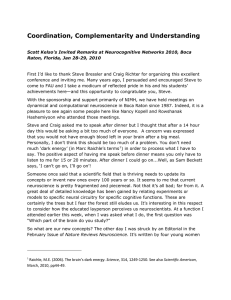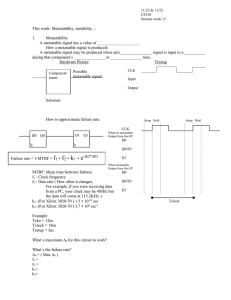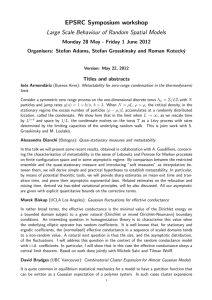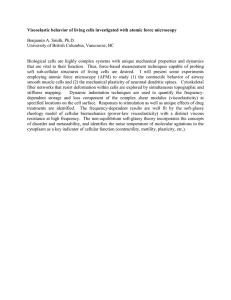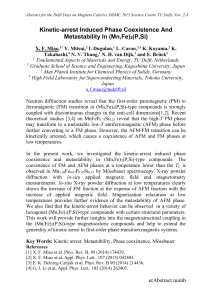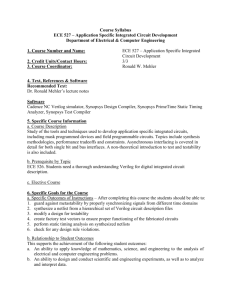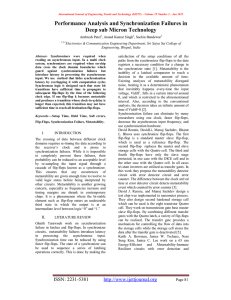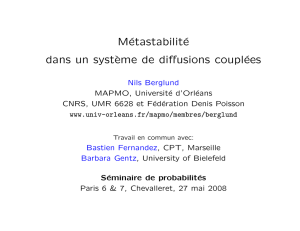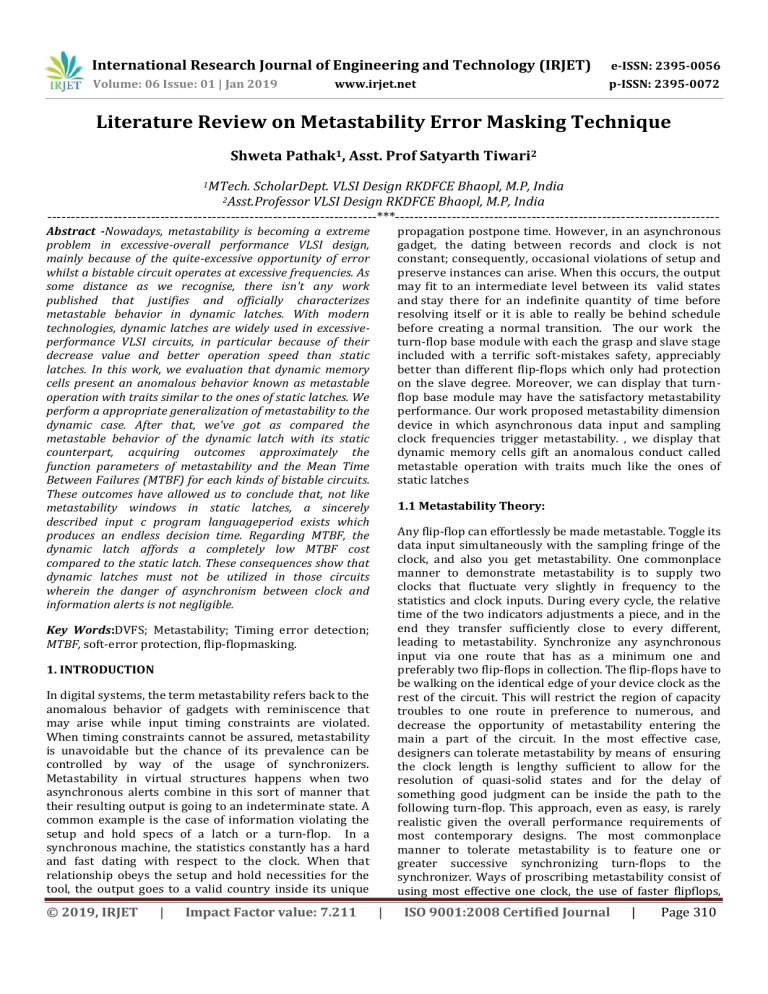
International Research Journal of Engineering and Technology (IRJET)
e-ISSN: 2395-0056
Volume: 06 Issue: 01 | Jan 2019
p-ISSN: 2395-0072
www.irjet.net
Literature Review on Metastability Error Masking Technique
Shweta Pathak1, Asst. Prof Satyarth Tiwari2
1MTech.
ScholarDept. VLSI Design RKDFCE Bhaopl, M.P, India
VLSI Design RKDFCE Bhaopl, M.P, India
----------------------------------------------------------------------***--------------------------------------------------------------------2Asst.Professor
Abstract -Nowadays, metastability is becoming a extreme
problem in excessive-overall performance VLSI design,
mainly because of the quite-excessive opportunity of error
whilst a bistable circuit operates at excessive frequencies. As
some distance as we recognise, there isn't any work
published that justifies and officially characterizes
metastable behavior in dynamic latches. With modern
technologies, dynamic latches are widely used in excessiveperformance VLSI circuits, in particular because of their
decrease value and better operation speed than static
latches. In this work, we evaluation that dynamic memory
cells present an anomalous behavior known as metastable
operation with traits similar to the ones of static latches. We
perform a appropriate generalization of metastability to the
dynamic case. After that, we've got as compared the
metastable behavior of the dynamic latch with its static
counterpart, acquiring outcomes approximately the
function parameters of metastability and the Mean Time
Between Failures (MTBF) for each kinds of bistable circuits.
These outcomes have allowed us to conclude that, not like
metastability windows in static latches, a sincerely
described input c program languageperiod exists which
produces an endless decision time. Regarding MTBF, the
dynamic latch affords a completely low MTBF cost
compared to the static latch. These consequences show that
dynamic latches must not be utilized in those circuits
wherein the danger of asynchronism between clock and
information alerts is not negligible.
propagation postpone time. However, in an asynchronous
gadget, the dating between records and clock is not
constant; consequently, occasional violations of setup and
preserve instances can arise. When this occurs, the output
may fit to an intermediate level between its valid states
and stay there for an indefinite quantity of time before
resolving itself or it is able to really be behind schedule
before creating a normal transition. The our work the
turn-flop base module with each the grasp and slave stage
included with a terrific soft-mistakes safety, appreciably
better than different flip-flops which only had protection
on the slave degree. Moreover, we can display that turnflop base module may have the satisfactory metastability
performance. Our work proposed metastability dimension
device in which asynchronous data input and sampling
clock frequencies trigger metastability. , we display that
dynamic memory cells gift an anomalous conduct called
metastable operation with traits much like the ones of
static latches
1.1 Metastability Theory:
Any flip-flop can effortlessly be made metastable. Toggle its
data input simultaneously with the sampling fringe of the
clock, and also you get metastability. One commonplace
manner to demonstrate metastability is to supply two
clocks that fluctuate very slightly in frequency to the
statistics and clock inputs. During every cycle, the relative
time of the two indicators adjustments a piece, and in the
end they transfer sufficiently close to every different,
leading to metastability. Synchronize any asynchronous
input via one route that has as a minimum one and
preferably two flip-flops in collection. The flip-flops have to
be walking on the identical edge of your device clock as the
rest of the circuit. This will restrict the region of capacity
troubles to one route in preference to numerous, and
decrease the opportunity of metastability entering the
main a part of the circuit. In the most effective case,
designers can tolerate metastability by means of ensuring
the clock length is lengthy sufficient to allow for the
resolution of quasi-solid states and for the delay of
something good judgment can be inside the path to the
following turn-flop. This approach, even as easy, is rarely
realistic given the overall performance requirements of
most contemporary designs. The most commonplace
manner to tolerate metastability is to feature one or
greater successive synchronizing turn-flops to the
synchronizer. Ways of proscribing metastability consist of
using most effective one clock, the use of faster flipflops,
Key Words:DVFS; Metastability; Timing error detection;
MTBF, soft-error protection, flip-flopmasking.
1. INTRODUCTION
In digital systems, the term metastability refers back to the
anomalous behavior of gadgets with reminiscence that
may arise while input timing constraints are violated.
When timing constraints cannot be assured, metastability
is unavoidable but the chance of its prevalence can be
controlled by way of the usage of synchronizers.
Metastability in virtual structures happens when two
asynchronous alerts combine in this sort of manner that
their resulting output is going to an indeterminate state. A
common example is the case of information violating the
setup and hold specs of a latch or a turn-flop. In a
synchronous machine, the statistics constantly has a hard
and fast dating with respect to the clock. When that
relationship obeys the setup and hold necessities for the
tool, the output goes to a valid country inside its unique
© 2019, IRJET
|
Impact Factor value: 7.211
|
ISO 9001:2008 Certified Journal
|
Page 310
International Research Journal of Engineering and Technology (IRJET)
e-ISSN: 2395-0056
Volume: 06 Issue: 01 | Jan 2019
p-ISSN: 2395-0072
www.irjet.net
decrease the asynchronous input frequency, and use
synchronization hardware. These steps can easy be taken
by using designers to boom the reliability of a circuit.
Layout editor to represnts the postpone degradation
because of metastability which affects the performance of
circuits which include timing simulation, strength
dissipation etc. The our work the flip-flop base module
with each the grasp and slave level included with a
exquisite gentle-error protection, significantly higher than
different turn-flops which simplest had protection at the
slave degree. Moreover, we will show that turn-flop base
module will have the first-rate metastability performance.
1.2 Literature survey:
GovindaSannenaet.Al [2016], timing error protecting
turn-flops were proposed, which might be proof against
metastability. The proposed flipflops take advantage of the
idea of both not on time statistics or pulse based totally
approach to come across timing mistakes. The timing
violations are masked through passing direct records
rather than master latch output to slave latch. Simulation
consequences show that the proposed flip-flops including
type A and kind-B reduce the error protecting latency as
much as 23% and forty two% respectively in usual
technique corners and growth the effective timing errors
monitoring window as compared to country of the art
metastable immune turn-flops [14]. The proposed turnflops may be used in dynamic voltage and frequency
scaling (DVFS) applications. A sixteen-bit adder is applied
to assess the capability of the proposed turn-flops in DVFS
body work and the simulation outcomes display that the
adder using the proposed flipflop can lessen up to 48%
electricity consumption or improve the overall
performance as much as 50% in regular method corners
compared to traditional worst case design.
David Liet.Al [2011]Flip-flop metastability is turning into
an important consideration for designing dependable
synchronous and asynchronous systems, particularly
inside the sub-threshold vicinity wherein it degrades
exponentially with the discount in supply voltage. In this
paper, particular evaluation is given at the layout of
metastablehardened turn-flops inside the sub-threshold
location. Proper transistor sizing the usage of either
transconductance or load variation together with
implementing the inverter pair inside the turn-flop graspstage with low-Vth can result in tremendous reduction in
the timeresolving steady τ. Extensive simulation effects
have proven that the most appropriate metastabilitystrength-delay-product (MPDP) layout allows the turnflops to improve its metastability with a more balanced
layout tradeoff among overall performance and strength
intake.
Manisha Thakuret.Al.[2014] Metastability occasions are
common in virtual circuits, and synchronizers are
necessary to defend us from their deadly results.
Originally synchronizers had been essential while
gambling an asynchronous input (this is, one synchronized
with the clock enter so that might change precisely while
the pattern). Everything adjustments can effortlessly be
metastable. Switch its data enter on the identical time that
the sampling fringe of the clock and you get Metastability.
The two alerts relative duration of every cycle varies a bit,
and eventually main to the metastability, close sufficient to
each other switches. This mixture of metastability with
normal display devices, arise often.
David Liet. Al. [2010]In this paper, we examine and
represent the metastability of eleven previously proposed
excessive-overall performance flipflops, reduced clockswing flip-flops, and level-converting flipflops. From
considerable simulation consequences in 65nm CMOS
generation, the primary metastability parameters of τ and
T0 are extracted and analyzed at each nominal and
decreased deliver voltage. Our simulation outcomes
indicate that these turn-flops exhibit a extensive variety
(up to few orders of magnitudes) of metastability
windows. In precise, flip-flops with differential and nice
comments configuration such as the sense-amplifier based
flip-flops show the maximum optimal metastability. Based
on this finding, a singular pre-discharge flip-flop (PDFF)
with superb comments configuration is proposed.
Extensive simulation consequences reveal that PDFF
achieves higher metastability than the preceding proposed
turn-flops at both nominal voltage supply and nominal
voltage supply with decreased clock-swing.
Mala Kushwahaet. Al. [2014]Our paintings proposed
metastability dimension device in which asynchronous
information input and sampling clock frequencies cause
metastability. , we exhibit that dynamic reminiscence cells
gift an anomalous conduct known as metastable operation
with traits much like those of static latches. During each
cycle, the relative time of the two alerts modifications a
bit, and in the end they transfer sufficiently near every
different, leading to metastability. One commonplace
manner to demonstrate metastability is to deliver clocks
that fluctuate very barely in frequency to the facts and
clock inputs. Microwind simulations had been
accomplished in an effort to quantify the put off, strength
and metastability performance of several flip-flops base
modules. A CMOS format is also applied in MICROWIND
© 2019, IRJET
|
Impact Factor value: 7.211
Antonio Cantoniet. Al. [2007]on this paper paper
characterized the metastability size system proposed in
[11] in which an asynchronous statistics input and clock
are used to trigger metastable failure in a bistable tool.
Our analysis indicates that the asynchronous input isn't
always uniformly allotted across the clock aspect but as an
alternative occupies discrete time instants. In unique, for
frequencies associated through rational numbers, as in
(1), it has been shown that the asynchronous data enter
|
ISO 9001:2008 Certified Journal
|
Page 311
International Research Journal of Engineering and Technology (IRJET)
e-ISSN: 2395-0056
Volume: 06 Issue: 01 | Jan 2019
p-ISSN: 2395-0072
www.irjet.net
visits a finite set of discrete factors with appreciate to the
clock aspect. We have confirmed experimentally the
discrete nature of the time interval among the
asynchronous data enter and the clock.
2. Approach for minimizing metastability
In the evaluation case, designers can tolerate metastability
by way of ensuring the clock duration is lengthy enough to
permit for the resolution of quasi-strong states as well as
something common sense can be inside the course to the
subsequent flip-flop. This method, whilst easy, is hardly
ever realistic given the overall performance necessities of
maximum cutting-edge designs.
Fig. 2Synchronizing an asynchronizing input
2. Design any country machines whose operation is laid
low with those “synchronized” indicators to follow a grey
code pattern among states controlled with the aid of those
indicators. Gray Code is a counting scheme where handiest
a single bit adjustments between numbers, as follows:
The next few techniques may be used to keep away from
metastability:
1. Synchronize any asynchronous input through one route
that has at least one and ideally two flip-flops in collection.
The flip-flops should be walking at the equal fringe of your
device clock as the rest of the circuit. This will restriction
the place of ability issues to at least one path in preference
to several, and minimize the opportunity of metastability
entering the main part of the circuit. Use buffered flipflops, or un-buffered turn-flops with minimum load. The
2nd flop's output might be accurate after clocks, due to the
fact the odds of metastable events occurring returned-tolower back is almost nil. In a sensible circuit, cascading
flip-flops nearly squares the probability of failure. With
two turn-flops, and at affordable information prices,
mistakes occur thousands and thousands or maybe
billions of years apart. Good sufficient for maximum
systems. But “correct” way the second level's output will
not be metastable: it is not oscillating, neither is it at an
unlawful voltage level.
000 001 011 010 one hundred ten 111 one zero one 100
Gray code makes sense if, and most effective if, your code
reads the tool quicker than it's far likely to trade, and if the
modifications show up in a fairly predictable style-like
counting up. Then there's no real danger of extra than a
unmarried bit changing between reads; if the inputs move
metastable, simplest one bit may be incorrect. The end
result will nevertheless be affordable. This will prevent
the country machine from “starting off” to unwanted
states should the synchronizing flip-flops be metastable.
[3]
3. As mentioned in advance, make sure that setup time of
the destination flip-flop is met. This will keep away from
the creation of metastable situations in the circuit and
minimize the propagation of any need to they arise.
There's nevertheless an same chance the price can be in
either felony good judgment kingdom. Thus, that is a
totally powerful approach. [8]
4. Compute a parity or checksum of the enter data earlier
than the capture sign up. Latch that into the sign up as
properly. Have the code compute parity and evaluate it to
that examine. If there may be an blunders, do some other
examine. [3]
5. Use metastability hardened Flip-flops (Their
clarification is past the scope of this document). [11]
Some designs will by no means have a metastability
problem. It constantly stems from violating setup or keep
instances, which in turn comes from either bad design or
asynchronous inputs. All of this discussion has revolved
around asynchronous inputs, when the clock and facts are
unrelated in time. Be wary of something no longer slaved
to the clock e.G. Interrupts in CPUs aren't synchronous to
processor clock. Be positive that these signal itself and the
vector generating good judgment, don't violate the
processor's set-up and maintain instances.
Fig. 1 Synchronizer
© 2019, IRJET
|
Impact Factor value: 7.211
|
ISO 9001:2008 Certified Journal
|
Page 312
International Research Journal of Engineering and Technology (IRJET)
e-ISSN: 2395-0056
Volume: 06 Issue: 01 | Jan 2019
p-ISSN: 2395-0072
www.irjet.net
Bad layout, although, can plague any digital system. Every
common sense factor takes time to propagate information.
When a signal traverses many devices, the delays can
upload up notably. If the facts then goes to a latch, it is
pretty feasible that the delays can also motive the enter to
transition on the same time as the clock. Instant
metastability. Designers are normally pretty cautious to
keep away from these conditions, even though. By
following those few precautions, the circuit may be proof
against the outcomes of metastability and more reliable.
6.
14. J. U. Horstmann, H.W. Eichel and R. L. Coates,
“Metastabilitybehavior of CMOS ASIC flip-flops in
theory and test.” IEEE
7.
J. of Solid-State Circuits 24(1), pp. 146–157,
February 1989.
8.
15. C. L. Portmann and T. H. Y. Meng,
“Metastability in CMOSSW2library elements in
reduced supply and technology scaled
3. CONCLUSION
9.
David Li, Pierce I-Jen Chuang, David Nairn,
ManojSachdev Department of Electrical and
Computer Engineering, University of Waterloo
Waterloo, Ontario, Canada 978-1-61284-6606/11/$26.00 © 2011 IEEE
Metastability is unavoidable in asynchronous systems
however cautious interest to design can commonly save
you the problem of violating setup and preserve instances.
The metastability traits of a tool depend upon the
procedure generation used for its design and the
environmental conditions. They have end up an increasing
number of frequent at better operating frequencies. When
higher frequencies are used, severe care must be taken to
make sure that gadget reliability isn't always adversely
affected because of inadequate synchronization
techniques. Various writer rent unique methods to
address the troubles bobbing up due to metastability, few
of which have been mentioned. No rely what approach is
used, those disasters should be accounted for in the layout
of asynchronous digital circuits.
10. Antonio Cantoni, Fellow, IEEE, Jacqueline Walker,
Member, IEEE, and Toby-Daniel Tomlin, Member,
IEEECharacterization of a Flip-Flop Metastability
Measurement Method IEEE TRANSACTIONS ON
CIRCUITS AND SYSTEMS—I: REGULAR PAPERS,
VOL. 54, NO. 5, MAY 2007
11. ManishaThakurNRI Institute of Information and
science Technology,Analysis of Metastability
Performance in Digital Circuits on Flip-Flop 2014
International Conference on Communication and
Network Technologies (ICCNT)978-1-4799-62662/14/$31.00 © 2014 IEEE
REFERENCES
1.
P. A. Stoll, “How to avoid synchronization
problems.” VLSIDesign 6, pp. 56–59, Nov/Dec
1982.
2.
10. J. Hohl, R.W. Larsen and L. C. Schooley,
“Prediction of errorprobabilities for integrated
digital synchronizers.” IEEE J. ofSolid-State
Circuits SC-19(2), pp. 236–244, April 1984.
3.
11. T. Sakurai, “Optimization of CMOS arbiter and
synchronizer circuits with sub micrometer
MOSFET’s.” IEEE J. of Solid-State Circuits 23(4),
pp. 901–906, Aug. 1988.
4.
12. L. S. Kim and R. W. Dutton, “Metastability of
CMOS latch/flip-flop.” IEEE J. of Solid-State
Circuits 25(4), pp. 942–951,Aug. 1990.
5.
M. J. Bellido, M.Valencia, A. J. Acosta, A. Barriga, J.
L. Huertasand R. Dom´ınguez-Castro, “A new
faster method for calculatingthe resolution
coefficient of CMOS latches: Designof an optimum
latch,” in 26th IEEE International Symposiumon
Circuits and Systems, May 1993, pp. 2019–2022.
© 2019, IRJET
|
Impact Factor value: 7.211
12. GovindaSannena⁎, Bishnu Prasad DasDepartment
of Electronics and Communication Engineering,
Indian Institute of Technology, Roorkee,
IndiaGovindaSannena⁎, Bishnu Prasad Das
Department of Electronics and Communication
Engineering, Indian Institute of Technology,
Roorkee, India Received 12 September 2017;
Received in revised form 7 November 2017;
Accepted 27 November 2017 Corresponding
author.
E-mail
address:
govinda.sannena@gmail.com
(G.
Sannena).INTEGRATION the VLSI journal 01679260/ © 2017 Elsevier B.V. All rights reserved.
13. Govinda Sannena1 and Bishnu Prasad Das2
Department of Electronics and Communication
Engineering Indian Institute of Technology,
Roorkee, India
14. K .Chae and S. Mukhopadhyay, “A dynamic timing
error
prevention technique in pipelines with
time borrowing andclock stretching,” IEEE Trans.
Circuits Syst. I Regul. Pap., vol. 61, no. 1, pp. 74–
83, Jan. 2014.
|
ISO 9001:2008 Certified Journal
|
Page 313
International Research Journal of Engineering and Technology (IRJET)
e-ISSN: 2395-0056
Volume: 06 Issue: 01 | Jan 2019
p-ISSN: 2395-0072
www.irjet.net
15. M. R. Choudhury, V. Chandra, R. C. Aitken, and
K.Mohanram, “Time-borrowing circuit designs
and hardwareprototyping for timing error
resilience,” IEEE Trans.Comput., vol. 63, no. 2, pp.
497–509, Feb. 2014.
16. Nejat, M. ,Alizadeh, B. , and Afzali-Kusha, A.,
“Dynamic flip-flop conversion: a time-borrowing
method for performance improvement of lowpower digital circuits prone to variations,” IEEE
Trans. Very Large Scale Integr. Syst., vol. 23, no.
11, pp. 2724–2727, Nov. 2015.
17. StefanosValadimas,
YiorgosTsiatouhas,
and
Angela Arapoyanni, "Timing error tolerance in
small core designs for SoC applications", IEEE
Trans. Comput., vol. PP, no. 99 (Early access).
18. Che-Min Huang, Tsung-Te Liu , and Tzi-Dar
Chiueh, “An energy-efficient resilient flip-flop
circuit with built-in timingerror detection and
correction,” in Proc. VLSI Design, Automation and
Test (VLSI-DAT), 2015, pp.1-4.
19. StefanosValadimas,YiorgosTsiatouhas,
A.
Arapoyanni, and PetrosXarchakos, “Effective
timing error tolerance in flipflop based core
designs,” J. electronic testing, vol. 29, no. 6,pp.
795–804, Dec. 2013.
© 2019, IRJET
|
Impact Factor value: 7.211
|
ISO 9001:2008 Certified Journal
|
Page 314

